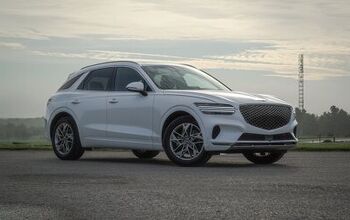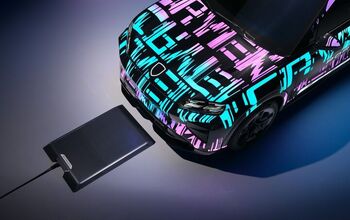2026 Genesis GV70 First Drive
“Even if it’s not broken, we can still make it better.”
So says Genesis Senior Research Engineer Jeong Hun Choi, spitting in the face of a well-worn cliché. Indeed, the Genesis GV70 was not broken. Quite the opposite. Style, quality, performance, comfort, value, you name it, the GV70 delivered, earning a multitude of accolades upon its release for 2022. Nevertheless, there were things to tweak and improve, if not outright fix, so for 2026, Choi and the rest of Team Genesis in Korea and North America went to work on a midcycle refresh that’s more substantial than it might seem.
The end result does not ruin a good thing, to borrow another cliché. The 2026 Genesis GV70 is indeed better and hasn’t picked up any bad habits in the process.
What’s New For 2026
There were updates made to almost all the areas covered in our review sections below, so let’s avoid redundancy and just dive right in.
Exterior Style
Yeah, I couldn’t tell the difference, either. But looking side-by-side, the lower front bumper intakes have been tweaked (with different designs for the Sport and all other trim levels), the exhaust outlets have either been reshaped (Sport) or hidden under the bumper (all other trims), and a new rear spoiler has been adopted. There are also new LED lighting elements in the carry-over split headlight housings, two new grille inserts based on trim, and a variety of new wheel designs. Oh, and the hood emblem’s “Guilloche pattern has been reduced.” Phew, it’s about time.
Powertrain And Efficiency
There’s even less to report here. The base engine remains a 2.5-liter turbocharged inline-four good for an ample 300 horsepower and 311 pound-feet of torque. Every GV70 is all-wheel drive. I did not get a chance to experience this engine during the drive event in Houston, but as the powertrain is unchanged, Kyle Patrick’s impressions from 2022 still apply.
The 3.5-liter twin-turbo V6 I tested also carries over with 375 hp and 391 lb-ft of torque. This is a stout powerplant with as meaty of a torque curve as its pound-feet would suggest, but it doesn’t wow and never conveys the same eager athleticism that the Porsche Macan’s twin-turbo V6 does with similar output.
It doesn’t need to, though. The GV70 isn’t a Macan, which is why its exclusive Sport+ drive mode comes across as trying way too hard. The eight-speed automatic excessively downshifts even if you’re driving in a straight line, the throttle pounds a double shot of espresso, and the piped-in engine noise gets turned up to 11. Perhaps it’s meant to appeal to the same customers who requested launch control be added. By the way, launch control has been added.
The fuel economy difference between the two engines isn’t that great: 21 mpg combined versus 22 or 23 depending on wheel selection, or 11.5L/100km versus 10.6 (regardless of wheel), so there’s minimal penalty besides about $8,000 USD or $11,000 CDN in going with the bigger motor.
Ride Quality And Comfort
You’re not just getting more power with the V6. It’s still the only way to get an electronically controlled limited-slip differential and the Preview Electronically Controlled Suspension that uses a forward camera, navigation system data, and even the adaptive cruise control sensors to preemptively adjust vehicle damping to mitigate impacts and body motions. Both of these also carry over, but Preview ECS in particular remains a pretty advanced chassis technology, especially at the GV70’s price point, that’s worthy of a call-out.
Every GV70 gains new hydraulic bushings for 2026 in place of traditional rubber ones to reduce vibration and harshness (the ol’ VH in NVH). The N was addressed with an upgraded active noise cancellation system, an extra noise damper inside the liftgate (joining one that was already there), and hollow resonators in the 21-inch wheel option that cancel out tire vibrations. I’m not sure how much quieter it is (a pre-refresh model was not available to drive back-to-back), but I can confirm the GV70 is a very quiet compact SUV.
A much larger steering wheel damper was also adopted to reduce fine steering vibrations. That also sounds like something that could possibly reduce steering feel, but I’m not sure how much the GV70 had to begin with. The steering continues to be surprisingly heavy in Comfort mode, which I appreciate but others may not, especially in parking lots. Furthermore, Sport is way too heavy, as if, again, the GV70 is trying too hard to be sporty. All the extra heft reduces response and further dulls feedback.
Interior Style And Quality
Like many vehicles in the Hyundai empire, the 2026 Genesis GV70 gets an interior overhaul to accommodate an ultra-wide instrument/infotainment display combo. However, unlike a Kia Sportage, for instance, the GV70’s doesn’t have two screens in one piano black housing: it’s a single 27-inch OLED display where the instrument and infotainment functions take up varying real estate depending on what functions you’re using and which of the many design configurations you’ve opted for. It’s beautiful and looks special. I’ll go into some of its functionality in the next section.
The dash below is reworked with new, touch-sensitive infotainment shortcut buttons and climate controls. Knobs are mercifully retained for volume, tuning/list selection, and dual-zone temperature control. A shout out to Genesis for keeping the radio shortcut button, which Hyundai and Kia ditched in favor of a Search button I’ve yet to find useful.
The center console was redesigned to accommodate a more accessible wireless phone charging pad, bigger cupholders (I can confirm they’re more useful), and a redesigned rotary shift knob that’s easier to differentiate from the similarly sized infotainment controller inches away. I still managed to grab one when I meant to grab the other, but I now realized my mistake before tuning to Sirius Channel 37 when I meant to put the car in Drive.
There is a new, three-spoke, flat-bottom steering wheel that replaces the two-spoke design I hear people didn’t like for some reason. The new one is nice to hold and still has physical buttons, toggles, and scroll wheels versus touch-sensitive nonsense. Materials quality seems just as exceptionally high as before, though ambient lighting enthusiasts will appreciate that an LED strip has been moved up higher on the doors to better showcase your preferred hue.
Speaking of hues, the interior color palette continues to be atypically vibrant for the luxury world. My Sport test vehicle was rocking Ultramarine blue with orange seat belts and contrast stitching, which is tastefully distinctive without looking all Edmonton Oilers. The all-red interior is an even brighter way to go.
Outside, the Ceres Blue paint you see here has been added (it replaces Brunswick Green in the U.S.). Canada gets a matte version of Ceres Blue, as well as metallic and matte versions of new Storr Green. You can also still get the Velvet Burgundy interior in Canada—it’s been discontinued in the States. Canadian Genesis product planner Rodrigo Rego told me the smaller market and easier ability for Canadian customers to special-order their cars allows for the extra, more colorful choices.
Tech And Safety
From a functionality standpoint, the new double-wide screen opens the door to a distinctive blending of the instrument and infotainment worlds. There’s a multitude of layout options available at the press of a steering wheel toggle, plus black and white background options selectable with the touchscreen. More notably, maps for both the native navigation system and Google Maps streamed from Android Auto/Apple CarPlay can appear in the middle 20-50% portions of the screen with driver-selectable gauges or vehicle information superimposed on top (or not at all).
In total, there’s a 30% increase in screen area for 2026, and it’s well utilized. There are a lot of big screens out there nowadays, but actual usability can seem like a secondary concern. Not so with this Genesis system. It’s easy to navigate thanks to big menu icons, those physical menu shortcut buttons, and simple controls for things like the native navigation system and the radio.
The voice recognition controls were also updated. They respond to a summons of “Hey Genesis,” with the “Hey” being a vital component. Simply saying the word “Mercedes” in conversation while driving an S-Class can annoyingly summon its digital butler. By contrast, I commented that “Carol Marcus invented the Genesis device in Star Trek II” and that “Phil Collins was the best drummer in Genesis.” No reaction, well done.
Should you be in the mood for some Phil Collins (no offence, I’m just trying to make the segue work), Genesis, the car company has abandoned its long association with the Lexicon high-end audio brand in favor of Bang & Olufsen. The new 16-speaker surround-sound system is definitely impressive, but who knows how much better it is compared to the old Lexicon system? Genesis says it is. Again, the car company, not Peter Gabriel.
Safety tech gets a boost, too. The forward collision warning system better detects vehicles coming from perpendicular directions (at street crossings, for instance) as well as oncoming traffic. Evasive steering assist was also improved, while the Remote Smart Parking Assist system was upgraded to now pull off diagonal and perpendicular parking. Audible warnings for various ADAS systems were also changed from a “ding” to a “boop.” Hurray.
Most noticeably, though, the adaptive cruise control system can pretty much operate hands-free now. Company reps strongly encouraged us to keep a hand on the wheel at all times for safety, but I kept my hands off (albeit primed for action) for an extended period of time that previously would’ve elicited a warning to put my hands on the wheel. The lane-centering steering system can also now utilize a forward-facing camera to follow the path of the vehicle ahead when lane markings disappear for a short period of time.
Value Dollars And Sense
Canadian pricing ranges from $60,000 to $73,000 for the three 2.5T trim levels, with the only 3.5T trim level, the Sport, coming in at $84,000. There are more options in the States, with a range of $47,985 to $58,795 for the four 2.5T trim levels, and a range of $63,415 to $70,095 for the two 3.5T Sport trim levels.
Equipment levels remain incredibly high throughout the ranges, with none of the nickel-and-diming you might find in other luxury brands. The base trims should feel loaded, especially in Canada with its even higher standard feature content. You’ll also be saving thousands versus a similarly equipped BMW X3 or Mercedes GLC.
Finally, a majority of GV70s are built in Alabama, but to meet demand, about 30% need to be built in Korea. In past years, that would’ve been a pointless factoid. Today, however…
Final Thoughts: 2026 Genesis GV70
Genesis made the GV70 better. Its changes were thoughtful, based on customer feedback and not just done for the sake of changing something (OK, except maybe the exterior tweaks). This compact luxury SUV remains a must-look in its segment.
Become an AutoGuide insider. Get the latest from the automotive world first by subscribing to our newsletter here.
More by James Riswick








































Comments
Join the conversation
What a friggin huge screen